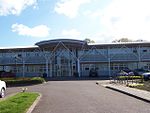The Chesterfield Canal is a narrow canal in the East Midlands of England and it is known locally as 'Cuckoo Dyke'. It was one of the last of the canals designed by James Brindley, who died while it was being constructed. It was opened in 1777 and ran for 46 miles (74 km) from the River Trent at West Stockwith, Nottinghamshire to Chesterfield, Derbyshire, passing through the Norwood Tunnel at Kiveton Park, at the time one of the longest tunnels on the British canal system. The canal was built to export coal, limestone, and lead from Derbyshire, iron from Chesterfield, and corn, deals, timber, groceries and general merchandise into Derbyshire. The stone for the Palace of Westminster was quarried in North Anston, Rotherham, and transported via the canal.It was reasonably profitable, paying dividends from 1789, and with the coming of the railways, some of the proprietors formed a railway company. It became part of the Manchester, Sheffield and Lincolnshire Railway company, and although there were intermittent plans to convert parts of it to a railway, it continued to thrive as a canal. In 1907, subsidence from local coal mines caused the collapse of the Norwood Tunnel, and the canal was effectively split in two. Subsequently, the main use of the Chesterfield end was the supply of water to the iron industry, while commercial carrying continued on the Worksop to West Stockwith section until the late 1950s.
It was formally closed in 1961, but campaigners fought for it to be retained, and the Worksop to Stockwith section was designated as a "cruiseway" under the Transport Act 1968, meaning that it would be retained for leisure use. The rest was designated as a remainder waterway, and parts were sold off, with housing being built over the route through Killamarsh. The Chesterfield Canal Society was formed in 1978 to spearhead restoration, becoming the Chesterfield Canal Trust in 1997. They initially sought to extend the navigable section beyond Worksop, but when progress was slow, moved to working on the Chesterfield end. Over 5 miles (8 km) of canal, including five original locks and a brand new lock at Staveley Basin were navigable by 2017. The eastern end was restored from Worksop to the mouth of the Norwood Tunnel at Kiveton Park near Rotherham, South Yorkshire, between 1995 and 2003, funded by Derelict Land Grants, English Partnerships and the Heritage Lottery Fund.
Less than 9 miles (14 km) of the original route remain to be restored to link the two navigable sections, but this will require some new lengths of
canal to be built, to bypass the housing development at Killamarsh, and to replace most of the Norwood Tunnel, which cannot be restored. The eastern section is managed by the Canal and River Trust, while the western section is managed by Derbyshire County Council. It includes Tapton Lock Visitor Centre, located to the north of Tapton Park, and the Hollingwood Hub, which provides offices for the Trust, together with meeting rooms and a cafe. It is located by Hollingwood Lock, and consists of a large new extension on the back of the refurbished lock house.










